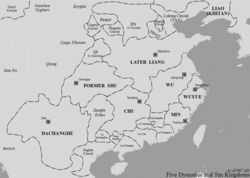Jin (Later Tang precursor)
Jin 晉 | |||||||||||||
|---|---|---|---|---|---|---|---|---|---|---|---|---|---|
| ?–923 | |||||||||||||
 | |||||||||||||
| Capital | Taiyuan | ||||||||||||
| Government | Principality | ||||||||||||
| Prince | |||||||||||||
• 896/907–908 | Li Keyong | ||||||||||||
• 908–923 | Li Cunxu | ||||||||||||
| Historical era | Five Dynasties and Ten Kingdoms Period | ||||||||||||
• Li Keyong created the Prince of Jin | 896 | ||||||||||||
• Established | ? | ||||||||||||
• Disestablished | 923 | ||||||||||||
| Currency | Chinese coin, Chinese cash | ||||||||||||
| |||||||||||||
| Today part of | China | ||||||||||||
Jin (晉; 883 (or 896 or 907)–923), also known as Hedong (河東) and Former Jin (前晉) in historiography, was an early state of the imperial Chinese Five Dynasties and Ten Kingdoms period until 923 when it became the Later Tang dynasty (923–937). Its rulers were the Shatuo warlords Li Keyong and Li Cunxu (Li Keyong's son). Although the Five Dynasties period began only in 907, Li Keyong's territory which centered around modern Shanxi can be referred to as Jin as early as 896, when he was officially created the Prince of Jin by the failing and powerless Tang dynasty court, or even (by extension, anachronistically) as early as 883, when he was created the jiedushi of Hedong Circuit, which controlled more or less the same territory.
History
The Jin rulers Li Keyong and Li Keyong's son Li Cunxu, of Shatuo extraction, claimed to be the rightful subjects of the defunct Tang Dynasty (618–907), in a struggle against the usurper state of the Later Liang Dynasty.
At the time of the Tang Dynasty's fall in 907, the Jin state consisted of most, but not all, of modern Shanxi, and eventually expanded to cover all of the territory north of the Yellow River. Eventually, in 923, Li Cunxu, claiming rightful succession to the Tang throne, declared himself emperor, transitioning his state to the Later Tang Dynasty, which shortly after destroyed the Later Liang Dynasty.
- Jin (Later Tang precursor)
- Later Tang
- Former countries in Chinese history
- 10th-century establishments in China
- 907 establishments
- 923 disestablishments
- 10th-century disestablishments in China
- States and territories established in the 900s
- States and territories disestablished in the 920s
- History of Shanxi
- Chinese history stubs
